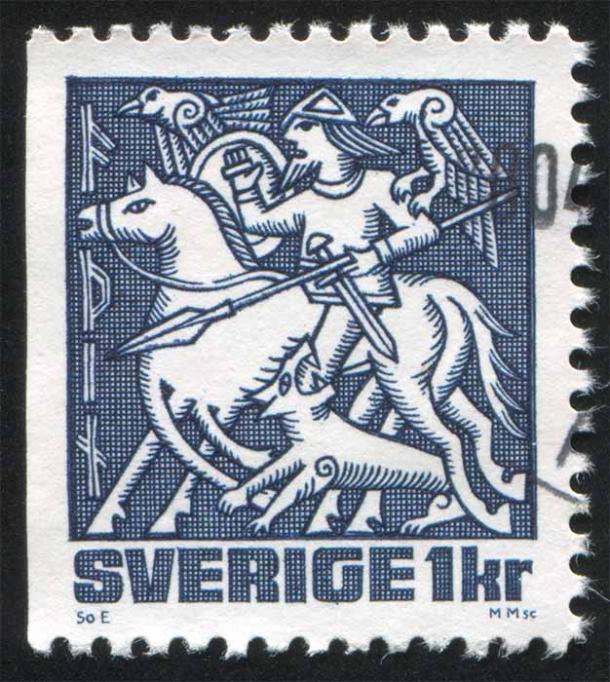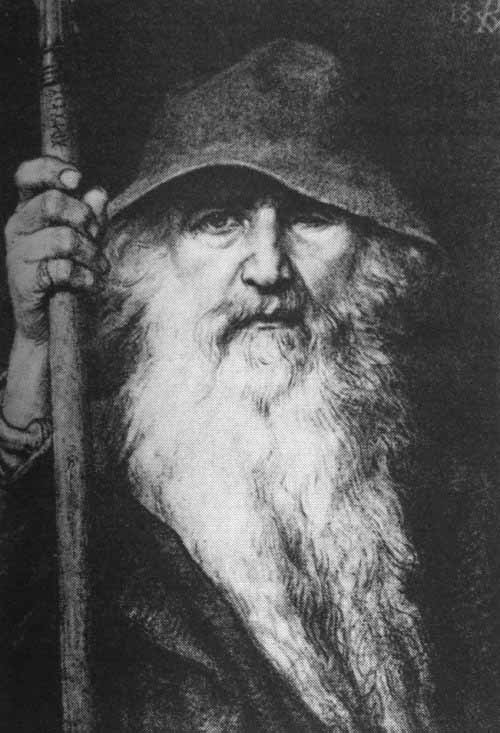
Of Runes And Sacrifice: The Initiation Ritual Of Odin in Norse Myth
The total of the poetic, mythological and sapiential heritage of the ancient and early medieval Scandinavian tradition is contained in the texts canonically collected under the title of Edda. Within this title are usually indicated two distinct dramas: one written in prose by the great Icelandic poet Snorri Sturluson (1170-1241 AD) around 1220 and therefore also known as Snorra Edda or Prose Edda, and the so-called Poetic Edda (Icelandic: Eddukvœdh), also compiled in Iceland by an anonymous author, or authors, around the middle of the same century. However, the original writing of the ritual of Odin poems originate from a much earlier period. The two epic collections, which also include the ritual of Odin passages, are thus revealed to be the legacy and the reworking of very ancient myths and traditions of the Norse (or Viking) people, in which acts of gods, men, heroic warriors (for example Siegfried, celebrated in the Nibelungenlied), sorcerers, giants, dragons, and monsters are revealed.
The Ritual Of Odin: Reveals A Norse God That Sees All
The traditional division between the two main groups of the Norse deities, which emerge from the Edda pages, is between the warlike Æsir or Asen gods, and the Vanir or Vanen gods, the gods related to natural cycles and dispensers of prosperity. The primordial conflict between these two groups of divine entities took place in ancient times, and their subsequent pacification guarantees the equilibrium of the cosmos.

The AEsir Norse gods gathered around the dead body of Baldr. Höd, Baldr’s blind brother, is standing on the left, stretching his arms out. On the very left, Loki tries to conceal his smile. Odin is sitting in the middle of the Æsir. Thor is on his left. (Christoffer Wilhelm Eckersberg / Public domain)
Belonging to the lineage of the Æsir, but at the same time above the entire pantheon of the Norse tradition, is the complex figure of Odin (also Oðinn or, in his ancient south-Germanic form, Wotan), the typical kind of Uranian lord who, from his throne in the otherworldly kingdom of Asgardhr, observes the whole world and the conduct of every man. This supremacy of the god is evident in other names attributed to him, such as alfoðr, the “father of all.”
- The Saga of Gestumblindi and Odin’s Riddles
- Gold Pendant Found in Denmark Depicts Norse God Odin, and May Have Been a Sacrifice to Avert the Disastrous Weather of 536 AD
- Odin’s Women – Goddesses Ignored, Forgotten and Denied Valhalla
The corpus of the Poetic Edda is composed of 29 poems, contained in a famous manuscript known as the Codex Regius N. 2365 (which has for centuries been the property of the Copenhagen University). And the first two texts of the collection—the Völospá and the Havamál—are particularly relevant for the image of Odin as a god of secret knowledge, and consequently master of the art of poetry.

Odin throws a spear at the Vanir host in the Norse Æsir-Vanir war of gods. (Lorenz Frølich / Public domain)
The exegesis and translation of these texts has always been subjected to many problems of interpretation, considering the profoundly obscure and hermetic linguistic expressions that characterizes this poetic tradition. The Völuspá or Völospá, whose title can be translated as “the prophecy of the Seer” or “the sayings of She who sees,” is a poem written in the form of a monologue by a Norse priestess devoted to Odin, a vǫlva or seer, who tells a vision describing the origin of the world and the final Ragnarok or Fall of the Gods, the end of this cosmic era. The following poem, the Havamál (“the speech of the High One” or “of the Exalted”), is presented as a gnomic poem, a text of sapiential character in which the god personally narrates his own primeval self-sacrifice.

On this Swedish stamp, Odin is depicted at the god of war and fury, but the two ravens suggest another aspect of Odin. The ritual of Odin reveals this Norse god’s spiritual, all-seeing side. ( rook76 / Adobe Stock)
Odin Was The God Of War, Fury And Poetic Insights
Odin stands out in Norse mythology, by definition, as a god related to war and destructive fury (though it happened in a more recent historical phase; Odin takes on this role from the more ancient Tyr, a divinity identified by Tacitus, in the Germania, with the Roman god Mars). It was traditionally believed that the fearsome Viking fighters known as berserkr and ulfeðnir , ferocious warriors possessed by authentic animal fury (respectively, of bear and wolf) were inspired by Odin.
In the 11th century, early ethnographer Adam of Bremen wrote about the customs of the pagan communities still present at the time in Sweden, reported that they worshiped “Odin,” who is the furor or supreme leader. His name, indeed, contains the same lexical root of the Norse word óðr (probably, the same as “Edda”), a term which means, as an adjective, “mad” or “possessed.” But as a noun the term would be translated as “spirit”, “thought” and even “poetry.”
Indeed, being the first and only king of the gods until the Ragnarok tale was written, Odin is the protagonist of various mythical narrations, and in many cases his actions seem to symbolize the typical human yearning to challenge the transcendent, and the will to obtain knowledge and wisdom. Also, in the Prose Edda, for example, is present a reference to the myth of Odin who steals the mead, the sacred drink that allows one to acquire the mastery of poetic art, from the giantess Gunnlöð.
The religious and linguistic scholar Jan De Vries has considered the Havamál as a sort of esoteric "manifesto" for the activity of an ancient priestly brotherhood devoted to the ritual of Odin in worship. In the poem, a vast part of the long text is dedicated to a sequence of maxims concerning the occurrences of daily life and the correct behavior in civil relations, The more strictly sapiential part of the work also includes some precious passages about the use of runes and magical songs, extending from stanzas 138 to 145.

The Runic alphabet and its Latin letter interpretation. (zeynurbabayev / Adobe Stock)
The Mystery And Sacred Nature Of Runic Alphabets
It has been proven that among the people of Germanic culture the Runic alphabet (later also called futhark, from the sound of the first six letters) was in use at least since the third century BC, long before the Latin alphabet reached the shores of the Baltic and the North Sea throughout the inkwells of Christian annalists (a class of Roman history writers; 218-78 BC).
Runic symbols were usually engraved on materials such as stone, bone and wood and developed during the Viking era in the various areas of Norse civilization (Denmark, Norway, Iceland, and above all Sweden). However, their origins would probably be found in an emanation and a reworking of the Northern Etruscan alphabets, the Latin alphabet and some writing systems used by the Celtic populations of the Alps.
Anyway, as is actually mentioned in many Eddic poems, it is unanimously recognized that in the Viking culture the runes also constituted a true symbolic cryptography. And, for this reason, their use in operations of magical and divinatory nature was highly relevant, as suggested in the etymology of the Old Germanic noun run, which means “secret” or “mystery.”

Odin the “wanderer” is the ritual of Odin side of this god, who observes all life and sees higher knowledge. (Georg von Rosen / Public domain)
The Ritual Of Odin: From Blind Ignorance To Seeing All Truth
Returning to the lyrics of the Havamál, in the ritual of Odin the god sacrifices an eye, which is offered to the fountain of Mímir, which stands among the roots of the cosmic Yggdrasil tree, in the infernal reign of Hellheimr. Therefore, losing part of that sight which perceives only outward appearances, and testing strictly his own body by hanging for nine nights from the branches of the ash-tree who symbolizes the axis mundi (“With bread they did not satisfy me nor with horns [they quenched my thirst],” says the poem, in stanza 139), the god is able to call the runes to himself, as the text says: “ I looked down, I raise the runes, calling them I did, and I fell from there” (idem).
If we consider the evident analogy with the figure of Homer, the blind master poet who sang of great heroes and of the gods “who were, who are and who will be,” and with many other similar cases (in Irish mythology, the blind person was depicted the wise druid Mog Ruith, such as were, even before that, the chantors of ancient Egypt), it is clear how the traditional message is always the same: the inspiration of the Muse cannot be manifested before the poet frees himself of what hides the knowing of the eternal.
With the gift of the runes, such as could do the shaman, the initiate or the great poets of ancient times who have passed through pain, sacrifice and even death to reach superior dimensions of existence, Odin can see (and hint to those who want to know) the transcendental and universal reality.
And, just like all the great ancient traditions, the Norse poems seem to tell us that the ecstasy of the ascetic ritual, such as the one caused by great poetry, is but a way to reconnect to the memory of eternal truths.
Top image: The Norse god Odin is known for war and fury but also for poetic insight, and the ritual of Odin, the pursuit of transcendent knowledge. Source: drakuliren / Adobe Stock
By Jari Padoan
References
Carrillo Rangel, David, Il regno di Odino, June 2018, in Storica (National Geographic) #112, Milan, National Geographic Society / RBA Italia s.r.l..
del Bianco, Mauro, Dialéghestai e Hagal Aett: l'idea della morte e il suo superamento nella tradizione greca e norrena, August 1988, in I Quaderni di Avallon #17, Rimini, Il Cerchio.
Dumézil, Georges, Gli dèi dei Germani – Saggio sulla formazione della religione scandinava, 1974, Milan, Adelphi.
Chiesa Isnardi, Gianna, I Miti Nordici, 1991, Milan, Longanesi.
Jones, Gwyn, A History of the Vikings, 1968, Oxford University Press, Oxford.
Gabrieli, Mario, Le letterature della Scandinavia, 1969, Milan-Florence, Sansoni/Accademia.
Gendre, Renato, Il futark, in AA.VV., Alfabeti- preistoria e storia del linguaggio scritto, 2000, Varese, Demetra.
Pörtner, Rudolf, Die Wikinger-Saga, 1971, Wien-Düsseldorf, Econ Verlag GmbH.
Literary opera:
Il Canzoniere Eddico (Eddukvœdhi), edited, introduced and translated from Norse by Piergiuseppe Scardigli and Marcello Meli, 2004, Milan, Garzanti.
La saga di Egill (Egils saga), 1997, edited by Marcello Meli, Milan, Mondadori.
Sturluson, Snorri, Edda (Snorra Edda), 1975, edited, introduced and translated from Norse by Gianna Chiesa Isnardi, Milan, Rusconi.
















Comments
Hi All,
I'll share this thought then leave it; I believed at first Norse Stories and other's similar to the Norse belief's were Myth's and there are so many of those Stories Globally.
However, I'm at an unusual place where I can no longer be so dismissive, because of another Book that I have read and Believe as Truth.
Now more than ever I know these guys like that of Odin an his children Thor as an example Did exist.
For those looking forward to their possible return; I'll just point to the lesson of Pandora's Box as a cautionary Testimony.
People are inclined to go there own way since Eden that's most likely not about to change even now.
That's all I wanted to say on the Topic of Odin, or Of Runes And Sacrifice. Until, next time Everyone, Goodbye!